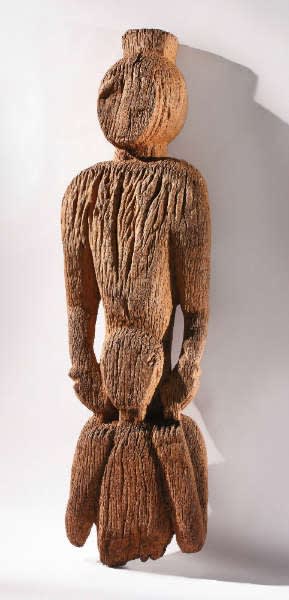
One of the sleepers in the last Sotheby’s sale in NY was this wonderful Ishan figure.
The iconography of two vertically stacked figures, in a “piggyback” positon, is frequently seen carved in relief on Ishan doors, but is comparatively rare in post figures. Regarding the significance of this iconography, Lorenz (1995) notes: “The piggyback figure is a multivalent image referring in a general sense to the stratification of Ishan society, in which some men are supported while others bear the burden. It also refers specifically to the former practice of the Enijie [kings] and warrior chiefs (Ekakulo, sing. Okakulo) who went to battle carried on the shoulders of a slave or orderly (Chief A.G. Idiahi, Uromi, Correspondence, 28 November 1983). Their elevated position allowed them to conserve energy, survey the battlefield, and issue clearly visible directives to their troops. Human porters were more accessible and reliable than horses, which do not survive long in the tsetse fly infested forests. The piggyback image is, therefore, probably more realisitic than the equestrian warrior (which also appears in Ishan doors), and is favored because of its polysemous nature. The piggyback image also refers to the ujie dance, part of the Ishan first burial ceremony, in which leadership in warfare is an important theme. During ujie, as witnessed today in Ishan villages, the sons of the deceased carry ebenlen swords of office as they are carried aloft in the manner of war leaders of old. Each son is joined by a large group of supporters from his otu (age set) who go into mock battle against the trees of the neighborhood (Ikekhua c.1960: 88-89), slashing off branches with which they beat the ground, whip the air, and make threatening gestures. Brandishing the freshly cut branches, which signify a recent death, the young men vigorously and jubilantly escort their favorite through the village to his father’s compound.”
It was photographed in situ at Iubiadan-Emu by Phillip Alison in 1960. Picture on the left in this field-photo, it is currently the only known surviving figure of this group.

At $ 25K (buyer’s premium included) this was an excellent deal.